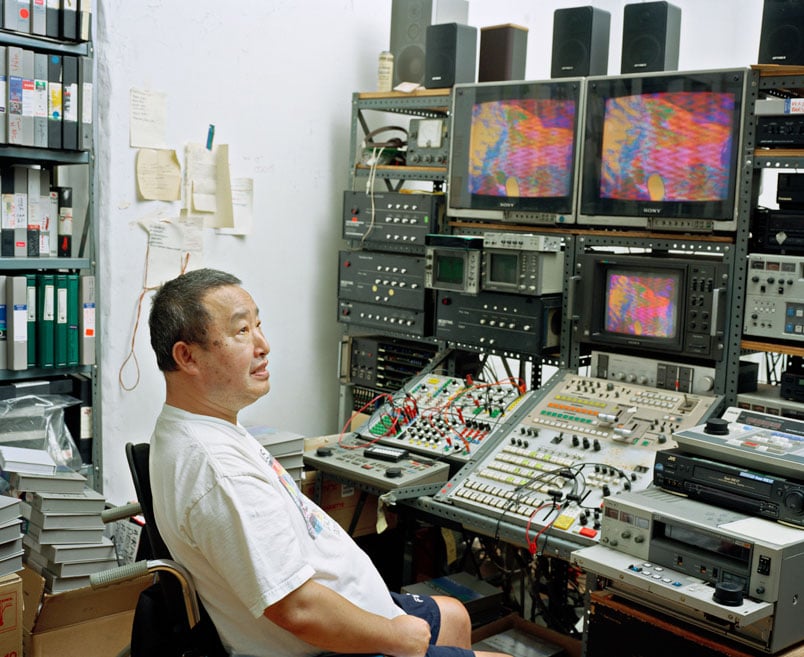
Born in Seoul, South Korea, in 1932, visionary artist Nam June Paik was always fascinated with technology, and his boundary-breaking work paved the way for new media practices around the world. Connections and collaborations formed the core of his interdisciplinary practice, whether it was working with choreographers, or other visual artists. The late artist moved to New York City in 1964, and died in Miami in 2006.
The “father of video art” would have celebrated his 83rd birthday today.
Nam June Paik. Untitled. 1993. © 2013 Estate of Nam June Paik.
Photo: Courtesy of The Museum of Modern Art.
1. He wrote his thesis on Arnold Schoenberg.
A true Renaissance man, Paik studied classical piano as a child and later, composition at the University of Tokyo. He wrote his thesis on Modernist composer Arnold Schoenberg, the inventor of the twelve-tone system.
2. John Cage initiated his career as a conceptual artist.
While continuing studies in musical history in Germany, Paik met Fluxus artist John Cage. Cage then introduced Paik to Marcel Duchamp, who had a “significant influence” on the development of Paik’s performance art. But Cage played an even more important role; Paik once said, “1957 was 1 BC (Before Cage). 1947 was the year 10 BC. Plato lived in 2500 BC and not 500 BC [Before Christ].”
Later introduced to both George Maciunas and Joseph Beuys, Paik joined the Fluxus troop in 1962, and contributed to make conceptual art in the spirit of both Duchamp and Cage.
Nam June Paik with Charlotte Moorman and K-456 at Paik’s Lispenard Street studio, Aug 17, 1964.
Photo Courtesy of Peter Moore / cyberneticzoo.com.
3. His collaborator was arrested for a topless performance.
In 1964, Paik moved to New York and began to collaborate with classical cellist Charlotte Moorman. They were introduced by friend and then-roommate, Yoko Ono. During a 1967 performance of Paik’s Opera Sextronique, Moorman was arrested for playing the score half-nude. The incident resulted in notoriety for Moorman, having then been labelled “The Topless Cellist.”
But this did not deter Moorman from participating in other curious performance pieces, such as playing a cello made of ice (which gave her frostbite) and playing while suspended from helium balloons.
4. He also collaborated with David Bowie.
In Wrap Around the World (1988), the British rocker performs among an international roster of artists and musicians. Paik provided the graphics and the satellite transmission. The artist had an answer to the skeptics who wonder why he bothers with this new technology: ”When people ask me why I do this silly thing, I ask, ‘Why do you climb Mount Everest?’ I think it’s human nature to seek out risk,” he told the New York Times.
The event was televised a week before the 1988 Summer Olympic Games in Seoul.
5. He was used to negative reviews.
In his book Postmodernism, or, the Cultural Logic of Late Capitalism (1991), Jameson writes that “only the most misguided museum visitor would look for the ‘art’ in the content of the video images themselves…” Ouch.
Nam June Paik, Electronic Superhighway: Continental U.S., Alaska, Hawaii, 1995.
Photo: Courtesy of the Smithsonian American Art Museum.
6. His 1995 work, Electronic Superhighway, features 336 televisions, 50 DVD players, 3,750 feet of cable, and 575 feet of multi-color neon tubing.
His installation, Electronic Superhighway: Continental U.S., Alaska, Hawaii, consisted of stacked televisions in the shape of the United States, along with neon tubing and steel scaffolding; the images glowed and flickered, each representing Paik’s view of a particular state (and state of mind).
In 2009, the Smithsonian American Art Museum acquired Paik’s archive, which included the anthropomorphic @PaikBot, along with Electronic Superhighway, and other works from the late artist.